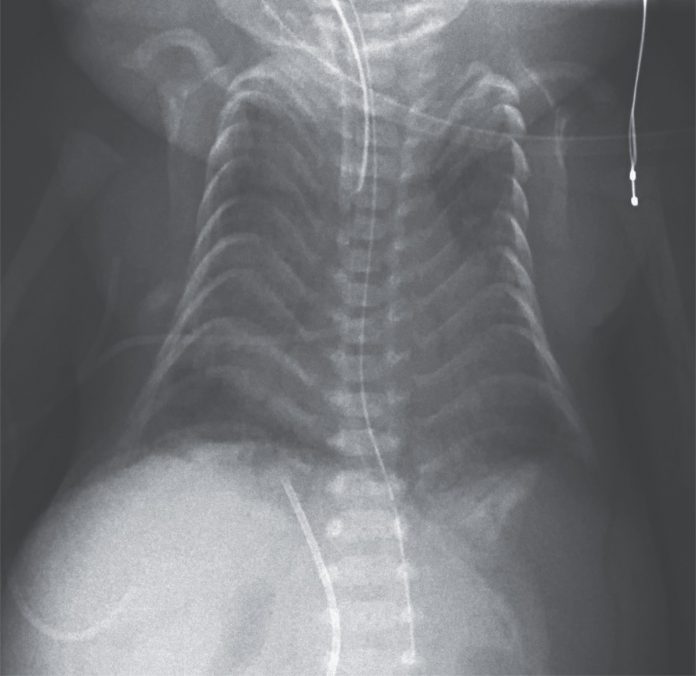
A baby boy was born at 28 weeks of gestation with respiratory distress. The neonate was intubated immediately, and surfactant was administered through the endotracheal tube.
Premature birth was attributable to preeclampsia due to which the baby was delivered via emergency cesarean section.
At 22 weeks of gestation, an antenatal ultrasound had shown polyhydramnios and omphalocele (abdominal organs outside the body in a sac due to a defect in the abdominal wall). Therefore, a giant omphalocele was noticed on the physical examination after birth along with webbed neck, and deformity of both hands.
Chest Xray on the first day of life showed a narrow rib cage with crowding of ribs in a “coat hanger” appearance.
A diagnosis of paternal uniparental disomy 14 was suspected.
The diagnosis was suspected based on antenatal studies, physical examination, and clinical manifestations.
Diagnosis of paternal uniparental disomy 14 was confirmed on genetic testing.
Unfortunately, the infant died after being on mechanical ventilation for 4 weeks. The cause of death was ruptured omphalocele and septic shock.
Uniparental disomy is when both copies of a gene are inherited from a single parent; when both copies are inherited from the father, it is called Paternal Uniparental Disomy. In the case in the discussion here, the baby inherited both copies of chromosome number 14 from the father, hence the name.
Paternal uniparental disomy 14 (patUPD14)is an extremely rare disorder with very few cases in the literature. Few, comparatively more common, heard examples of UPD are Prader-Willi (matUPD15), Beckwith-Wiedemann syndrome (patUPD11), and Russell-Silver syndrome (matUPD7).
PatUPD14 has been observed to have a distinctive clinical picture in almost all the reported clinical cases to date. Multiple hernias/omphalocele, abnormal facies, premature birth, skeletal dysplasia, respiratory insufficient at birth, history of polyhydramnios in pregnancy, and the characteristic “coat hanger” deformity of the ribs.

Image Source: Journal of Perinatology
The presence of ‘coat hanger’ rib deformity and omphalocele are the hallmarks of patUPD14, which help to differentiate it from other causes of small thorax and skeletal dysplasias.
Prognosis of paternal uniparental disomy 14 is quite poor due to respiratory insufficiency, and neurodevelopmental retardation. However, it is imperative to give genetic counseling to parents.
References
Faeq Al-Mudares, M. a. (2020, March 26). Coat Hanger” Appearance of the Ribs. Retrieved from The New England Journal of Medicine: https://www.nejm.org/doi/full/10.1056/NEJMicm1910897
Sargar, K., Herman, T. & Siegel, M. Paternal uniparental disomy of chromosome 14. J Perinatol 34, 723–725 (2014). https://doi.org/10.1038/jp.2014.24
Ogata, T., Kagami, M. Kagami–Ogata syndrome: a clinically recognizable upd(14)pat and related disorder affecting the chromosome 14q32.2 imprinted region. J Hum Genet 61, 87–94 (2016). https://doi.org/10.1038/jhg.2015.113



